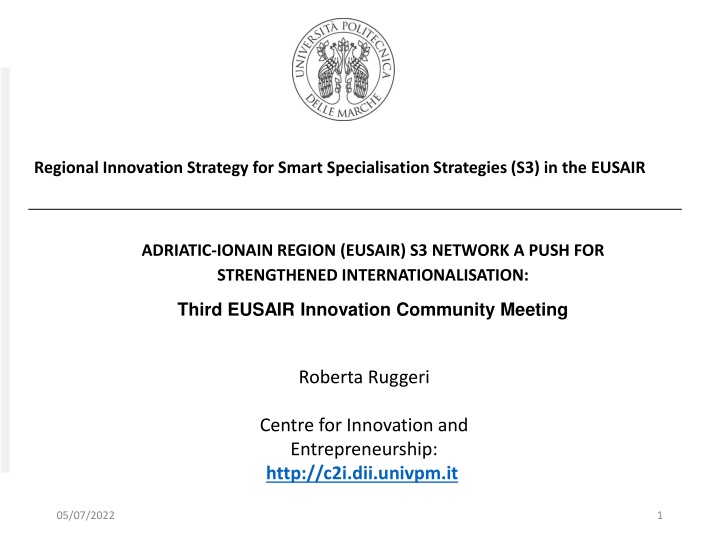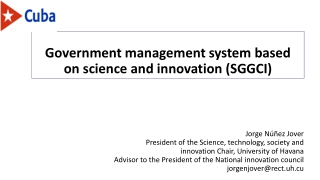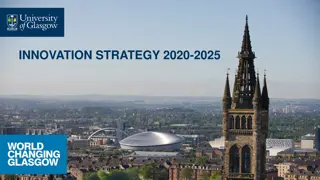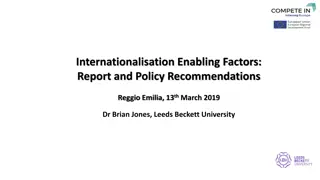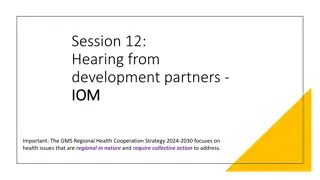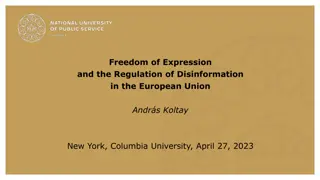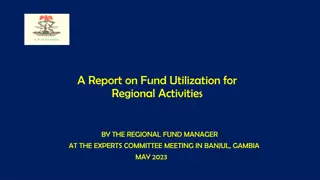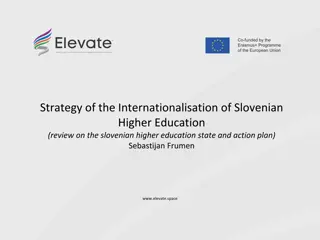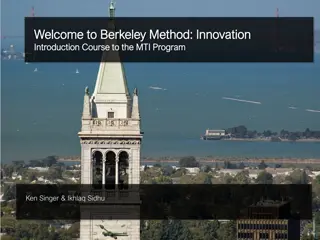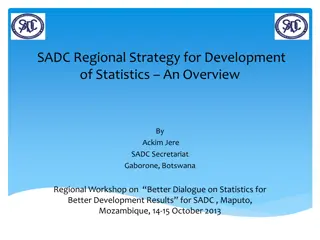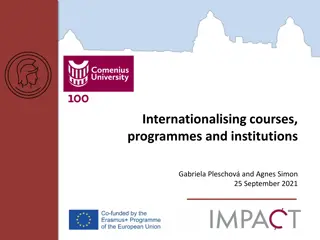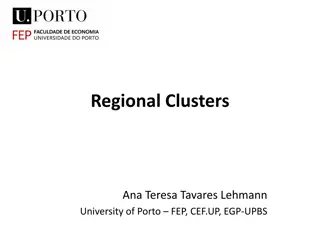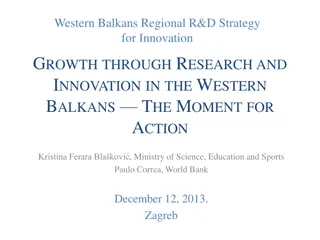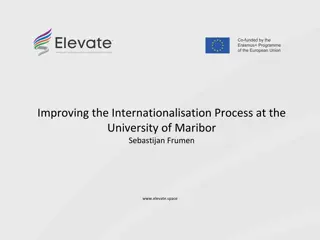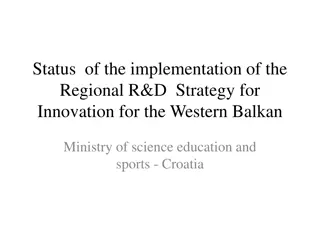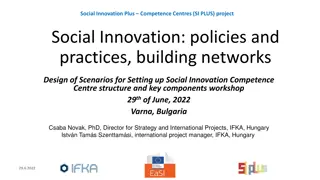Strengthened Internationalisation through Regional Innovation Strategy
The Regional Innovation Strategy for Smart Specialisation Strategies (S3) in the EUSAIR Adriatic-Ionian Region focuses on assessing the overlap between EUSAIR pillars and S3 areas. Smart specialisation emerged as a key concept for cohesion policy, aiming to bridge the gap between Europe and the USA in economic and technological specialisation. By concentrating resources for R&D and innovation in key domains, S3 policies act as catalysts for innovation and competitiveness.
Download Presentation

Please find below an Image/Link to download the presentation.
The content on the website is provided AS IS for your information and personal use only. It may not be sold, licensed, or shared on other websites without obtaining consent from the author.If you encounter any issues during the download, it is possible that the publisher has removed the file from their server.
You are allowed to download the files provided on this website for personal or commercial use, subject to the condition that they are used lawfully. All files are the property of their respective owners.
The content on the website is provided AS IS for your information and personal use only. It may not be sold, licensed, or shared on other websites without obtaining consent from the author.
E N D
Presentation Transcript
Regional Innovation Strategy for Smart Specialisation Strategies (S3) in the EUSAIR ADRIATIC-IONAIN REGION (EUSAIR) S3 NETWORK A PUSH FOR STRENGTHENED INTERNATIONALISATION: Third EUSAIR Innovation Community Meeting Roberta Ruggeri Centre for Innovation and Entrepreneurship: http://c2i.dii.univpm.it 05/07/2022 1
Regional Innovation Strategy for Smart Specialisation Strategies (S3) in the EUSAIR Background Background Aims Aims Data and Data and Methodology Methodology Empirical Empirical Results Results Remarks Remarks 17/06/2022 Siepi Conference 2022 2
Aims Provide an empirical assessment of the actual overlap between the EUSAIR pillars and the S3 areas indicated by EUSAIR countries and regions in the programming period 2014-2020. 3
Background The concept ofsmart specialisation emerged within the Knowledge for Growth expert group (Foray et al. 2009) It was taken by the European Commission as the central pillar of the 2014-2020 cohesion policy (European Commission, 2010). Ex ante condition for the allocation of ESI funds under 2014-2020 TO1 (research and innovation) 4
Background S3 in cohesion policy Dissatisfaction for the results of cohesion policy (raising inequalities among regions) Need for placebased policy at regional level (2009 - Barca report on cohesion policy) More effective link between R&D and innovation (Foray et al. 2009) Structural "gap" between Europe and the USA, as result of a lower economic and technological specialisation and lower ability to prioritize efforts and investments at regional level Taking into account national contributions and other private investment, the impact of Cohesion Policy for 2014-2020 is expected to be about EUR 450 billion EU Commission 5
Background The Smart Specialisation Strategy (S3) pillars the concentration of (public and private) resources for R&D and innovation in few technological domains (specialisation) the specialisation domains must be chosen to complement the research and productive assets in which regions show superior innovative capabilities(smart) 6
Background S3 policies as catalyst of innovation and competitiveness. Key issues R&D/innovation Core regions/peripheral regions Specialisation/diversification Industry sectors/technological domains Top down/bottom up Coherence/relatedness s/connectivity 7
Background The Smart Specialisation Strategy (S3): a key concept The S3 guide (Foray et al., 2012) emphasizes that in designing S3 regions should consider the actual and potential links between the domains knowledge exchanges between different domains at regional level (relatedness) knowledge exchanges between different regions specialising in similar or complementary domains (connectivity). 8
Background The importance of connectivity Innovation smart specialisation is also pointing regions towards more strategic cross-border trans-regional cooperation to achieve more critical potential and related variety. In designing S3 regions they should consider the actual and potential links between the domains knowledge exchange between different domains at regional level (relatedness) knowledge exchange between different regions specialising in similar or complementary domains (connectivity). and Complementarity Relations regions (at the frontier of technology) and peripheral regions (applying technology to specific domains) between core such The S3 guide (Foray et al., 2012) 9
Background Entrepreneurial discovery process should be the result of a bottom-up process to involve all the main private and public stakeholders according to the 4 helix approach entrepreneurs must be understood in a broad sense (firms, higher education institutions, public research institutes, independent inventors and innovators) and include whoever is in the best position to discover the domains of R&D and innovation in which a region is likely to excel given its existing capabilities and productive assets S3 Guide(Foray et al. 2012). 1 0
Background EU Macro-Regional Strategies 2009 emerged as integrated 2015 framework(s) during the same time span 2011 2014 3 main, broad, interconnected priorities in common: 1) environment and climate change 2) research & innovation and economic development 3) connectivity (transport, energy, digital networks)
Background EUSAIR aims and pillars 4 main pillars 2 Cross-Cutting aspects (capacity-building; research and innovation) 2 horizontal principles for all the four pillars (climate change mitigation and adaptation, disaster risk management)
Background Ex-ante conditionality 2014-2020 within Europe s 2020 strategy S3 represented the key feature of reformed Cohesion Policy (Radosevic, 2017) a major novelty for the allocation of cohesion funds; specifically, funds addressed to foster research and innovation TO1 (research and innovation) S3 required countries and regions to choose key areas on which to concentrate resources. Public and private investment in R&D and innovation should be focused (Foray, 2014). Non-EU countries were not required to design S3 to access TO1 ERDF funds. But given the transformative approach of S3 and the interest for the pre-accession countries to align their policies with the acquiscommunautaire , some of them designed development strategies following the requirements of S3 (i.e. Montenegro, Serbia (Capello et al., 2020; Matusiak and Kleibrink, 2018). 1 4
Data and methodology Classification and mapping of EUSAIR pillars Pillars Topics Key-words Shipbuilding 1.1 Blue tehnologies Marine technologies Blue economy sectors Fisheries Identified from the description of pillars Aquaculture 1. Blue Growth 1.2 Fisheries and Aquaculture Aquatic ecosystems Seadfood production Marine services 1.3 Maritime and marine governance and services Marine governance Sea basin governance Maritime security 2.1 Maritime transport Marine transports 2.Connectingtheregion Terrestrialtransports 2.2 Intermodal connections to the hinterland Intermodal connections 2.3 Energy networks Gas and power networks Aquatic ecosystems Marine environment 3.1 The marine environment Water pollution 3.Environmental Quality Waste management Coastal environment 3.2 Transnational terrestrial Habitats and Biodiversity Marine and terrestrial biodiversity Demand seasonality 4.1 Diversified tourism (Products and Services) Cultural industry 4. Sustainable Tourism Sustainable tourism 4.2 Sustainable and Responsable Tourism Cultural heritage
Empirical Results About a quarter of the specialisation areas indicated by regions and countries in their S3 documents are related to EUSAIR pillars. The overlapping is mostly observed for the pillars referring to sustainable tourism and connecting the regions (energy and transportations) while blue growth and environmental quality show a low presence in S3 specialization areas.
Data and methodology The analysis covers 33 territorial units (countries/regions) with info at relevant territorial level NUTS 2 S3 Platform + direct examination of S3 documents and the identification of specialisation areas Two main limitations in collecting information no common way to indicate S3 areas of specialisation. no homogeneity in the definition and classification Further check for validation of the previous analysis; Opencoesione database - consider the actual allocation of funds rather than the initial intentions declared in S3 documents. Collected information on the actual projects financed under TO1. For Italian regions.
Empirical Results Italian regions - 14 EUSAIR territorial units out of 33 - The empirical analysis refers to slightly less than 20,000 projects with an overall amount of more than 7 billion euros. Number of projects financed with ERDF-TO1 funds Amount of public funds allocated to project under ERDF TO1 2014-2020 (million Euros) two pillars: pillar 1 (Blue Growth) and Pillar 4 ( by regions 2014-2020
Empirical Results Share of projects and funds referring to EUEAIR pillars 1 and 4 under ERDF TO1 2014-2020 (% on total) - blue growth pillar 1 only two regions, Friuli Venezia Giulia and Veneto, show a significant share of projects and funds. In the case of FVG this is coherent with the S3 priorities. Veneto did not explicitly prioritise blue pillar topics in its S3 document. Puglia and Sicilia indicated blue growth topics in their S3 documents but allocated a very small share of funds to them. - Sustainable tourism pillar 4 indicated by almost all regions. But only some of them allocated a significant share of 3 regions, Friuli Venezia Giulia, Veneto, and Sicilia show a significant share of their S3 projects with the two pillars considered. Basilicata and Molise show a significant share only in pillar 4. All the other regions show a percentage of funds around or under 1% of total funds funds: Basilicata, Sicilia, Molise, Friuli Venezia Giulia, and Veneto. No projects for Marche and Trentino Alto Adige. .
Research question Background Data and methodology Empirical results Conclusions Final remarks Both the implementation of S3 and MRSs are based on a complex architecture of multilevel governance. Both S3 and MRSs are based on the identification of sectoral priorities - embedding EUSAIR - has a predefined set of themes (pillars) S3 - countries and regions are free to choose their specialisation areas EUSAIR already consolidated framework to develop S3 The overlapping between S3 specialization areas and EUSAIR pillars is less widespread than expected. Only on quarter of S3 specialization areas may by associated with EUSAIR pillars and topics. Most common association to sustainable tourism (tourism and cultural heritage) and connecting the region (energy and transport). Only a few of the EUSAIR regions and countries selected topics related to blue growth and environmental quality. Possible explanations: - S3 was designed before the institutions of EUSAIR - the attention to environmental and marine issues has raised during the last decade 20
Final remarks - In the framework of the 3 No s principle: (no new EU legislation, no new EU institutions, no new EU fundings) on which macro regional strategies are based it is essential to effectively use existing instruments and funds to attain macro- regional objectives. It is important to take advantage of existing instruments and funds. - The integration between macro-regional pillars and S3 specialisation areas is specifically relevant in this regard; the two strategies share important similarities in their objectives and implementation process. - EUSAIR is unique in that it involves countries states potentially eligible to join EU (soft skills acquis communautaire) - The integration between S3 and the macroregional strategy is specifically important for the non-EU EUSAIR countries to enhance their development policy and speed up the accession process to the EU transformative logic 21
Centre for Innovation and Entrepreneurship: http://c2i.dii.univpm.it
